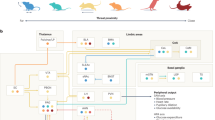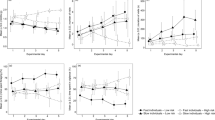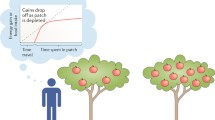Abstract
Foraging rats (Rattus norvegicus) are vulnerable to, and must protect themselves from, two kinds of threat. Conspecifics will attempt to steal their food and they themselves will be subject to predation. To safeguard their food and themselves they are able to call upon a surprising number of strategies and defensive maneuvers. This paper summarizes their defensive strategies, the stimulus features of their surroundings that modify these strategies, and the cognitive processes that they use to evaluate their susceptibility to threat. Their strategies are discussed both as antecedents of human behavior and in relation to their relevance in understanding brain function.
Similar content being viewed by others
References
BARNETT, S. A., & SPENCER, M. M. (1951). Feeding, social behaviour and interspecific competition in wild rats. Behaviour; 3, 229–242.
BLANCHARD, R. J., BLANCHARD, D. C., WEISS, S. M., & MEYER, S. (1990). The effects of ethanol and diazepam on reactions to predatory odors. Pharmacology Biochemistry and Behavior, 35, 775–780.
CALHOUN, J. B. (1962). The ecology and sociology of the Norway rat. Bethesda, MD: U. S. Department of Health, Education, and Welfare.
CHITTY, D. (1954). The control of rats and mice, Vols. 1 and 2: Rats. Oxford, England: Clarendon Press.
EWER, R. F. (1971). The biology and behavior of a free-living population of black rats (Rattus rattus). Animal Behavior Monographs, 4, 126–174.
GALEF, B. G., Jr. (1983). Utilization by Norway rats (R. norvegicus) of multiple messages concerning distant foods. Journal of Comparative Psychology, 97, 364–371.
GALEF, B. G., Jr., & WIGMORE, S. W. (1983). Transfer of information concerning distant foods: A laboratory investigation of the “information-center” hypothesis. Animal Behaviour, 31, 748–758.
LIMA, S. L. (1985). Maximizing feeding efficiency and minimizing time exposed to predators: A trade-off in the black-capped chickadee. Oecologia, 66, 60–67.
LIMA, S. L. (1987). Distance to cover, visual obstructions, and vigilance in house sparrows. Behaviour, 102, 231–238.
LIMA, S. L., VALONE, T. J., & CARACO, T. (1985). Foraging-efficiency-predation-risk trade-off in the grey squirrel. Animal Behavior, 33, 1155–165.
LORE, R. K., & FLANNELLY, K. (1978). Habitat selection and burrow construction by wild Rattus norvegicus in a landfill. Journal of Comparative and Physiological Psychology, 92, 888–896.
MARX, M. (1950). A stimulus-response analysis of the hoarding habit in the rat. Psychological Review, 57, 80–94.
MCNAMARA, R. K., & WHISHAW, I. Q. (1990). Blockade of hoarding in rats by diazepam: An analysis of the anxiety and object value hypotheses of hoarding. Psychopharmacology 101, 214–221.
MILLER, G. A. (1945). Concerning the goal of hoarding behavior in the rat. Journal of Comparative Psychology 38, 209–212.
MILLER, G. A., & POSTMAN, L. (1946). Individual and group hoarding in rats. American Journal of Psychology, 652–668.
MUNN, M. L. (1950). Handbook of psychological research on the rat. Boston: Houghton Mifflin.
PHELPS, M. T., & ROBERTS, W. A. (1989). Central-place foraging by Rattus norvegicus on a radial maze. Journal of Comparative Psychology, 103, 326–338.
PINEL, J. P. J., MANA, M. J., & WARD, J. A. (1989). Stretched-approach sequences directed at localized shock source by Rattus norvegicus. Journal of Comparative Psychology 103, 140–148.
PISANO, R. G., & STORER, T. I. (1948). Burrows and feeding in the Norway rat. Journal of Mammalogy 29, 374–383.
POSADAS-ANDREWS, A., & ROPER, T. J. (1983). Social transmission of food preferences in adult rats. Animal Behavior, 31, 265–271.
ROSS, S., SMITH, W. I., & WOESSNER, B. L. (1955). Hoarding: An analysis or experiments and trends. Journal of General Psychology, 52, 307–326.
SAPPINGTON, A. A. (1990). Recent psychological approaches to the free will versus determinism issue. Psychological Bulletin, 1, 19–29.
TAKAHASHI, L. K., & LORE, R. K. (1980). Foraging and food hoarding of wild Rattus norvegicus in an urban environment. Behavioral and Neural Biology; 29, 527–531.
VALONE, T. J., & LIMA, S. L. (1987). Carrying food items to cover for consumption: The behavior of ten bird species feeding under the risk of predation. Oecologia (Berlin), 71, 286–294.
WHISHAW, I. Q. (1988). Food wrenching and dodging: Use of action patterns for the analysis of sensorimotor and social behavior in the rat. Journal of Neuroscience Methods, 24, 169–178.
WHISHAW, I. Q. (1990). Time estimates contribute to food handling decisions by rats: Implications for the neural control of hoarding. Psychobiology 18, 460–466.
WHISHAW, I. Q., & GORNY, B. P. (in press). Postprandial scanning by the rat (Rattus norvegicus): The importance of eating time and an application of “warm-up” movements. Journal of Comparative Psychology.
WHISHAW, I. Q., NICHOLSON, L., & ODDIE, S. D. (1989). Food-pellet size directs hoarding in rats. Bulletin of the Psychonomic Society 27, 57–59.
WHISHAW, I. Q., & ODDIE, S. D. (1989). Qualitative and quantitative analyses of hoarding in medial frontal cortex rats using a new behavioral paradigm. Behavioural Brain Research, 33, 255–266.
WHISHAW, I. Q., ODDIE, S. D., McNAMARA, R. K., HARRIS, T. L., & PERRY, B. S. (1990). Psychophysical methods for the study of sensory-motor behavior using a food-carrying (hoarding) task in rodents. Journal of Neuroscience Methods, 32, 123–133.
WHISHAW, I. Q., SUTHERLAND, R. J., & KOLB, B. (1983). The analysis of behavior in the laboratory rat. In T. E. Robinson (Ed.), Behavioral approaches to brain research. New York: Oxford.
WHISHAW, I. Q., & TOMIE, J. (1987). Food wresting and dodging: Strategies used by rats (Rattus norvegicus) for obtaining and protecting food from conspecifics. Journal of Comparative Psychology 101, 202–209.
WHISHAW, I. Q., & TOMIE, J. (1988). Food wrenching and dodging: A neuroethological test of cortical and dopaminergic contributions to sensorimotor behavior in the rat. Behavioral Neuroscience, 102, 110–123.
WHISHAW, I. Q., & TOMIE, J. (1989). Food-pellet size modifies the hoarding behavior of foraging rats. Psychobiology, 17, 83–101.
WOLFE, J. B. (1939). An exploratory study in food-storing in rats. Journal of Comparative Psychology, 28, 97–101.
Author information
Authors and Affiliations
Corresponding author
Additional information
The Canadian Natural Sciences and Engineering Research Council of Canada is thanked for their support for this research.
Rights and permissions
About this article
Cite this article
Whishaw, I.Q., Gorny, B.P. & Dringenberg, H.C. The Defensive Strategies of Foraging Rats: A Review and Synthesis. Psychol Rec 41, 185–205 (1991). https://doi.org/10.1007/BF03395105
Published:
Issue Date:
DOI: https://doi.org/10.1007/BF03395105




